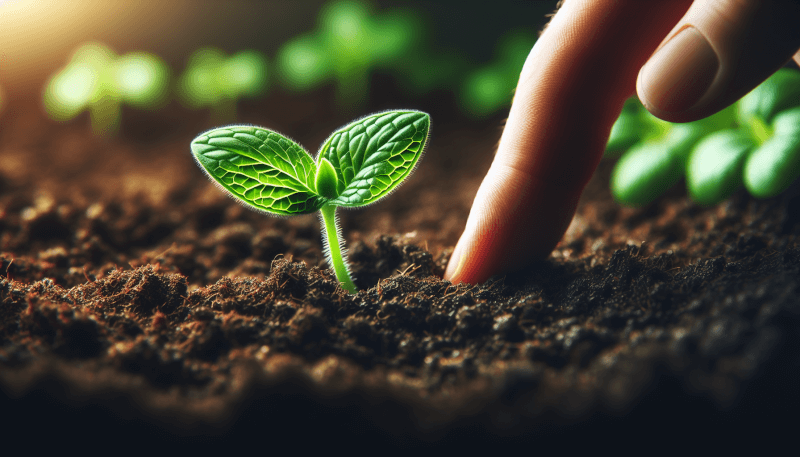👋 Click the mic button to talk to Alfred, the Todd's Seeds Gardening/Sprouting Expert – Feel free to ask him anything!
Ask Virtual Todd Anything - Click the Mic
Are you interested in learning how to grow sprouting seeds? Look no further! This article will provide you with all the information you need to start growing your own sprouts at home. Whether you have a large garden or just a small indoor space, we will guide you through the simple steps of sprouting seeds and help you enjoy a fresh and nutritious addition to your meals. So, grab your gardening gloves and get ready to embark on a rewarding journey of sprouting seeds!

Choosing Seeds to Sprout
When it comes to sprouting seeds, it is crucial to start with high-quality seeds to ensure successful sprouting. Assessing seed viability is an important step in choosing the right seeds. To determine the viability of seeds, you can conduct a simple test called the “float test.” Fill a bowl with water and place the seeds in it. If the seeds sink to the bottom, they are usually viable and suitable for sprouting. On the other hand, if the seeds float, it indicates that they may not be viable and might not sprout properly.
In addition to assessing seed viability, choosing organic seeds is highly recommended. Organic seeds are free from synthetic chemicals or genetically modified organisms (GMOs), making them healthier and more environmentally friendly. Look for seeds labeled as organic or certified organic to ensure the highest quality.
You can also choose different types of seeds to sprout, depending on your preferences and needs. Some popular options include alfalfa seeds, broccoli seeds, mung beans, sunflower seeds, and radish seeds. Each type of seed has its unique flavor profile and nutritional benefits, so experimenting with different seeds can add variety to your sprouting endeavors.
Preparing Seeds for Sprouting
To ensure optimal sprouting conditions, it is important to properly prepare the seeds before sprouting. The first step is rinsing the seeds. Rinse the seeds thoroughly under running water to remove any dirt or debris. This process will help clean the seeds and improve their chances of sprouting successfully.
After rinsing the seeds, soaking them is the next crucial step. Soaking seeds before sprouting helps to activate their natural enzymes and initiates the sprouting process. Place the rinsed seeds in a bowl or jar and cover them with water. Let the seeds soak for the recommended time, which varies depending on the type of seed. Generally, soaking seeds overnight or for at least 6-8 hours is sufficient.
Once the soaking time is up, it is important to drain and rinse the seeds again. This step helps to remove any residual soaking water and prevents the growth of mold or bacteria. Use a colander or a fine-mesh sieve to drain the seeds thoroughly. Rinse them under running water to ensure they are clean and ready for sprouting.

Sprouting Methods
There are several methods you can use to sprout seeds, depending on your preferences and the resources you have available. Three popular methods are jar sprouting, tray sprouting, and hemp bag sprouting.
Jar Sprouting
Jar sprouting is a simple and convenient method that requires minimal equipment. To start, choose a suitable jar for sprouting. Mason jars with mesh or sprouting lids work well, as they allow for proper drainage and air circulation.
Before sprouting, prep the jar by thoroughly cleaning and sterilizing it to prevent any contamination. Ensure that the sprouting lid or mesh is securely attached to the jar.
To begin the sprouting process in jars, add the soaked seeds to the jar and spread them out evenly. Place the jar at an angle, allowing excess water to drain out while still providing air circulation. Rinse the seeds twice a day, draining any excess water each time. After rinsing, invert the jar to ensure proper drainage. Within a few days, you will start to see sprouts emerging from the seeds.
Tray Sprouting
Tray sprouting is ideal for larger quantities of sprouts and provides more space for growth. Start by selecting the right tray for sprouting. Flat trays with drainage holes or sprouting trays specifically designed for sprouting seeds are recommended.
Before using the tray, prepare it by cleaning and sterilizing thoroughly. Ensure that the tray has proper drainage holes to prevent waterlogging.
Once the tray is ready, evenly spread out the soaked seeds on the tray, ensuring they are not too crowded. Place the tray in a well-ventilated area with indirect light.
To promote sprouting, rinse the seeds twice a day, allowing excess water to drain out through the drainage holes. After rinsing, ensure that the tray is tilted to ensure proper drainage. With regular rinsing and proper care, the sprouts should start emerging within a few days.
Hemp Bag Sprouting
Hemp bag sprouting is a unique method that allows for easy sprouting and excellent air circulation. Choose a hemp bag that is specifically designed for sprouting. Hemp bags are favorable for sprouting as they are breathable and provide an ideal environment for the seeds to sprout.
Before using the hemp bag, soak it in water for a few minutes and rinse it thoroughly. This process helps remove any impurities and prepares the bag for sprouting.
Once the bag is ready, add the soaked seeds to the bag, ensuring they are spread evenly. Hang the hemp bag in a well-ventilated area.
To promote sprouting, rinse the bag twice a day, allowing excess water to drain out completely. After rinsing, hang the bag back in its designated spot. Sprouts should start emerging from the seeds within a few days, and the hemp bag will provide excellent airflow for their growth.
Maintaining Optimal Sprouting Conditions
To ensure successful sprouting, it is crucial to maintain optimal sprouting conditions throughout the process. This includes providing adequate moisture, ensuring proper air circulation, and controlling temperature and light.
Providing Adequate Moisture
Moisture is essential for sprouting seeds. Regular rinsing and draining of the seeds help maintain the right moisture levels. Ensure that the seeds are always moist but not soaking wet. Avoid waterlogging, as it can lead to mold growth and spoil the sprouts.
Ensuring Proper Air Circulation
Proper air circulation is crucial for healthy sprouting. It helps prevent the buildup of excess moisture and ensures a constant supply of fresh air. In jar sprouting, ensure that the sprouting lid or mesh allows for airflow. In tray or hemp bag sprouting, choose a well-ventilated area and make sure that excess water can drain away easily.
Controlling Temperature and Light
The temperature and light conditions for sprouting may vary depending on the type of seed. In general, sprouting seeds prefer room temperature, ranging from 18-24°C (65-75°F). Avoid exposing sprouts to direct sunlight, as it can cause overheating. Instead, provide indirect light or place the sprouts in a shaded area.

Common Sprouting Problems and Solutions
While sprouting seeds is a relatively simple process, it is essential to be aware of common problems that may arise and know how to address them.
Mold or Mildew Growth
One common issue during sprouting is the growth of mold or mildew. To prevent this, ensure that the seeds and sprouting equipment are clean and properly rinsed. Maintain proper air circulation and avoid waterlogging. If mold or mildew does appear, discard the affected sprouts and sanitize the sprouting equipment thoroughly.
Foul Odor
If you notice a foul odor during sprouting, it may indicate bacterial growth. Ensure that the seeds are properly rinsed and drained to discourage bacterial growth. If the odor persists, it is best to discard the sprouts and start again with fresh seeds and equipment.
Stunted or Yellow Sprouts
Stunted or yellow sprouts may indicate a lack of adequate moisture, poor drainage, or insufficient nutrients. Ensure that the seeds are properly rinsed and drained, providing optimal conditions for sprouting. If the problem persists, consider adjusting the sprouting method or choosing a different seed variety.
Harvesting and Storing Sprouts
Once the sprouts have reached the desired length, it’s time to harvest them. Determine the right harvest time based on your preferences. Some sprouts are typically harvested when they have developed their first set of true leaves, while others are harvested when they are still in the early stages of growth.
To harvest the sprouts, gently pluck them from the seed or substrate they are growing in. Rinse the sprouts thoroughly to remove any debris or seed hulls. Use them immediately or store them for future use.
To store sprouts, place them in a clean, breathable container such as a glass or plastic container lined with paper towels. Store them in the refrigerator to help retain their freshness. It is best to consume sprouts within a few days of harvest for optimal taste and nutritional value.

Using Sprouts in Recipes
Sprouts are versatile and can be incorporated into a wide range of recipes, adding a fresh and nutritious touch. Here are some popular ways to use sprouts in recipes:
Raw Sprouts in Salads and Wraps
One of the simplest and most popular ways to enjoy sprouts is raw, in salads and wraps. Add sprouts to your favorite salad mix or wrap fillings for a crunchy texture and a burst of flavor. They are particularly delicious in combination with fresh vegetables, herbs, and a tangy dressing.
Cooked Sprouts in Stir-fries and Soups
Sprouts can also be cooked to enhance their flavors and textures. Add them to stir-fries or soups during the last few minutes of cooking for a delightful crunch and added nutrients. They are a great addition to Asian-style dishes, bringing a refreshing element to the overall flavor profile.
Blended Sprouts in Smoothies and Juices
For a unique twist, blend sprouts into smoothies or juices. Their mild flavors and nutritional benefits complement fruits and vegetables nicely. Experiment with different combinations to create your own refreshing and healthy beverages.
In conclusion, sprouting seeds can be an enjoyable and rewarding experience. By following the proper methods and maintaining optimal conditions, you can grow fresh, nutritious sprouts right at home. Remember to choose high-quality seeds, prepare them carefully, and utilize suitable sprouting methods. With a little patience and care, you’ll soon be enjoying the vibrant flavors and health benefits of your home-grown sprouts.